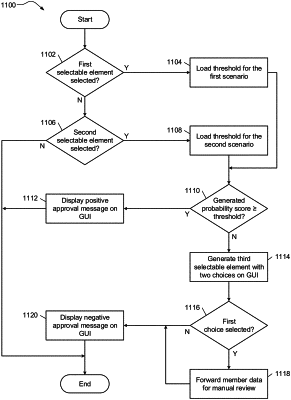| CPC G06F 3/0482 (2013.01) [G06F 9/451 (2018.02); G06F 16/22 (2019.01); G06N 20/00 (2019.01); G16H 20/10 (2018.01)] | 20 Claims |

|
1. A computerized method for transforming an interactive graphical user interface according to machine learning, the method comprising:
selecting a persona from a data store, wherein the data store is stored by a remote networked storage device that is remote from the interactive graphical user interface;
loading, into a data processing module, a data structure from the remote networked storage device, wherein the data structure is associated with the selected persona;
generating the interactive graphical user interface comprising:
a first selectable element, and
a second selectable element;
in response to a user selecting the first selectable element:
loading, at the data processing module, a first trained machine learning model from the remote networked storage device,
loading, at the data processing module, a first set of explanatory variables from the data structure,
inputting, at the data processing module, the first set of explanatory variables to the first trained machine learning model to generate a first metric, and
transforming the user interface according to the selected persona and the first metric;
in response to the user selecting the second selectable element:
loading, at the data processing module, a second trained machine learning model from the remote networked storage device,
loading, at the data processing module, a second set of explanatory variables from the data structure,
inputting, at the data processing module, the second set of explanatory variables to the second trained machine learning model to generate a second metric, and
transforming the user interface according to the selected persona and the second metric,
wherein the first trained machine learning model is different from the second trained machine learning model, and
wherein the first metric is a first probability of a user described by the persona being approved for a first prior authorization prescription; and
automatically approving the first prior authorization prescription in response to reaching a first threshold value.
|